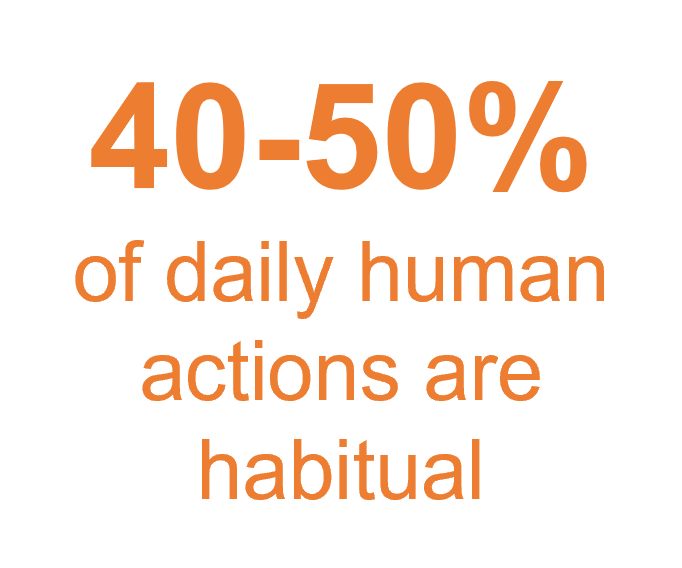 Habits are notoriously hard to break. It’s estimated that up to 80% of attempts to break a ‘bad habit’ fail*. But the reality is most of our habits aren’t ‘bad,’ they are simply decisions that have become automatic, subconscious. Thinking of habits in this way, we see that as much as 45% of what we do in a day is guided by habits or subconscious decision making. Yet, as marketers our job is to find ways to modify these ingrained, subconscious behaviors. To induce this change, it is crucial to thoroughly understand the factors that motivate (Drivers of Change) versus the obstacles (Barriers to Change) we face.
Habits are notoriously hard to break. It’s estimated that up to 80% of attempts to break a ‘bad habit’ fail*. But the reality is most of our habits aren’t ‘bad,’ they are simply decisions that have become automatic, subconscious. Thinking of habits in this way, we see that as much as 45% of what we do in a day is guided by habits or subconscious decision making. Yet, as marketers our job is to find ways to modify these ingrained, subconscious behaviors. To induce this change, it is crucial to thoroughly understand the factors that motivate (Drivers of Change) versus the obstacles (Barriers to Change) we face.
So, when we seek to learn about the drivers and barriers that guide decision making, is it any wonder simply asking people results in uninspiring, predictable responses? If the behavior we are trying to influence is ‘habitual’ like so much of our lives are, people simply cannot express what really guides their decisions. That’s why, as anyone who has conducted Drivers & Barriers research knows, too often these studies return surface level drivers and barriers and fall short of discovering any insight that will truly change behavior.
So, what’s a better way? Well, we must get our customers beyond their top-of-mind, rational responses. Legacy research methods do not address the inherent conflict and tension that exists in the decision-making process. We’ve found all it takes is creating a little tension in the ‘room.’ Rather than simply asking someone how they make a decision, we bring folks with opposing views together to ‘hash it out.’ This shift in approach fundamentally shifts the perspective, allowing for more genuine and reflective conversation that truly digs into what is behind decisions that may have become habitual.

This technique, which we call S+R Guided Deliberations™ is a unique methodology grounded on the breakthrough social science work coming from our partnership with the University of Chicago Law School to develop a jury decision-making model based on rigorous social-science principles. Guided Deliberations™ digs deep into human decision making but observing, rather than asking, how decisions are made. It’s an observational, respondent-led approach that brings customers with differing views together to debate the case and challenges them to attempt to build consensus.
Through this provocative process our trained researchers listen closely for how arguments are constructed, what ‘evidence’ is used, and how each side answers back to the others’ argument. This approach has several critical advantages over traditional ‘ask and answer’ approaches to drivers and barriers work:
- Tension exposes latent insight: The inherent tension created via debates provides raw, authentic discussion. This allows us to uncover heuristics, non-rational drivers and hidden biases impacting decision-making. At times, we’ll ask participants to ‘switch roles’ arguing for the opposite side. This shift is highly effective in exposing biases that participants likely could not have articulated in a traditional setting.
- Sticking + tipping points emerge: The back-and-forth nature of debate reveals the sticking points and tipping points that exist and how they might be overcome, informing the most effective ways to drive behavior change. Having to respond to the case made by others challenges customers to reflect and results in insights previously hidden, sometimes even to the customers themselves.
- Compelling, natural language revealed: We hear how customers construct arguments and make decisions amongst themselves. This tells us what matters most and the specific, customer-inspired language to use to impact behavior.
Case Study: Discovering levers to pull to kick-start a slow launch
Despite certain competitive advantages, after more than a year of launch in the Hyperkalemia space, our client’s product uptake was not as strong as expected. It was critical to deeply understand how to disrupt the habit of using the previous standard of care and the barriers to adoption of our client’s product. This meant pinpointing levers needed to break habits and increase use of our client’s product.
We designed a Guided Deliberations™ initiative that mixed groups of SoC loyalists and new product users. The result was highly engaging debates that exposed tensions and revealed the beliefs and biases each physician leaned into. We discovered that while many logistical and practical barriers were in fact in place, there was also a more personal, emotional barrier that kept doctors from adoption. As the groups debated and attempted to build consensus, these sticking and tipping points were made clear. We observed what physicians needed to know and believe (about the drug and themselves) to overcome sticking points and tip towards adoption.
Ultimately, clear themes in belief structures emerged, revealing strategies that could move the needle tailored to the bias to overcome rather than the physician’s specialty. The resulting strategic recommendations provided compelling ways to frame their messages, inject “nudges” into communications and customer experience, as well as a strategic platform that would work effectively across this very diverse set of physician specialties.
 We achieved what is often lacking in Drivers & Barriers research – clarity on how to break habits and drive behavior change in the absence of strong clinical differentiation. We provided the client team with clarity into the biases at play, how to either ‘feed’ or ‘fight’ these biases, and clear strategic implications to increase the odds of success. This research also provided the necessary evidence to justify increasing sales force efforts and provided direction on what type of conversations and narrower topics sales representatives should focus on. These actions resulted in measurable improvement in market share, after a slower than expected launch.
We achieved what is often lacking in Drivers & Barriers research – clarity on how to break habits and drive behavior change in the absence of strong clinical differentiation. We provided the client team with clarity into the biases at play, how to either ‘feed’ or ‘fight’ these biases, and clear strategic implications to increase the odds of success. This research also provided the necessary evidence to justify increasing sales force efforts and provided direction on what type of conversations and narrower topics sales representatives should focus on. These actions resulted in measurable improvement in market share, after a slower than expected launch.
This is just one example why we have been voted in the annual GRIT report as the #1 strategic insights consultancy. If you would like to hear more about how we can spark transformative outcomes to help you shape not just respond to the future, please reach out to us at [email protected].


